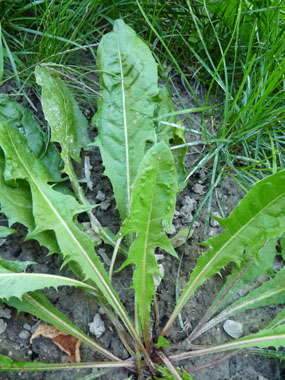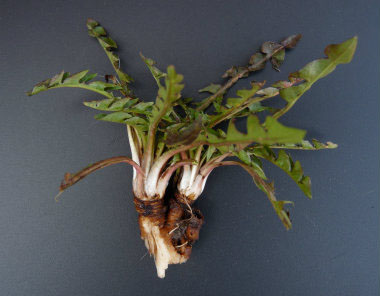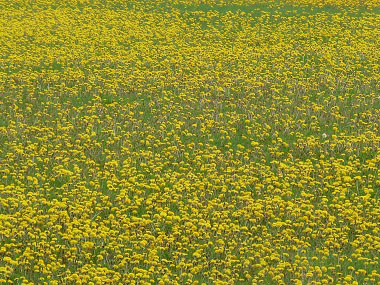











For comprehensive information (e.g. nutrition, health benefits, recipes, history, harvesting tips, etc.) please check out our Dandelion PDF magazine.
Dandelions are often considered a pesky weed in Canada and the U.S. yet European and Asian nations have greatly benefited for years from the incredible nutritional value that this weed contains. They are a rich source of vitamins, minerals and it even has antioxidants. For example, one cup of raw dandelion greens contains 112% of your daily required intake of vitamin A and 535% of vitamin K. The common yellow dandelion has a long list of powerful healing abilities as well as other health benefits. Contrary to popular belief, this is a beneficial plant to have. It’s a great companion plant for gardening because it’s long taproot brings up nutrients to the shallow-rooting plants in the garden adding minerals and nitrogen to the soil. It also attracts pollinating insects such as bees, which helps fruits to ripen.
Distinguishing Features
The dandelion is a readily identifiable, hardy, perennial weed. It has a rosette base producing several flowering stems and multiple leaves.
Flowers
The common dandelion flowerhead has about 150 to 200 yellow ray florets and no disk florets; the ray florets spread outward from the center. At the base of the flowerhead, there are inner and outer bracts that are green. The inner bracts are linear or linear-lanceolate and appressed together to form a cylindrical tube around the ovaries of the flowerhead. The outer bracts are linear-lanceolate and sharply curve downward. Flowers are produced sporadically from early spring to late autumn.
 Fields
of Nutrition has medicinal benefits and vitamin/mineral content of Dandelion.
Fields
of Nutrition has medicinal benefits and vitamin/mineral content of Dandelion.
Leaves
Dandelions have a toothy, deeply-notched, basal leaves that are hairless. They are 5 to 25 cm or longer and they form a rosette above the central taproot.
Height
Depending on several conditions, dandelions can grow as high as 25-30 cm.
Habitat
Dandelions are the most common broadleaf weed in most lawns. It is found in virtually every kind of habitat, from openings in deep woods to cultivated fields, from rocky hillsides to fertile gardens and lawns.
Edible Parts
Leaves, root, and flower. The leaves can be added to a salad or cooked, and can be dried and stored for the winter (they can also be blanched and frozen). Flowers can be made into juice, or added into many recipes. The root can be made into a coffee substitute, and the root along with the leaves can be dried, stored and made into tea.
Other Name
Lion’s Tooth.
Similar Plants
Red Seeded Dandelion, Agoseris.
Recipes
Baked Dandelion, Belgium Wild Beer, Wild Tonic Tea, Chicken Weed Wrap, Dandy Banana Bread, Dandelion Fritters, Dandelion Iced Tea, Lemon Cupcakes, Peanut Butter Cookies, Dandy Syrup, Dandelion Vinegar, Dandy Muffin Tops, Dandy Pasta, Fermented Wild Edibles, Herbal Shampoo, Hosta Rolls, Leek and Nettle Soup, Wild Mustard Pesto, Sesame and Wilted Green Saute, Super Stacked Sauerkraut, Weed Soup, Wild Pizza
To support our efforts please browse our store (books with health benefits, etc.).
Winter Survival Food Handbook

PDF Plant Magazines
Types of Wild Food
Geographic Zones Seasons
Disclaimer
EdibleWildFood.com is informational in nature. While we strive to be 100% accurate, it is solely up to the reader to ensure proper plant identification. Some wild plants are poisonous or can have serious adverse health effects.
We are not health professionals, medical doctors, nor are we nutritionists. It is up to the reader to verify nutritional information and health benefits with qualified professionals for all edible plants listed in this web site. Please click here for more information.
Why Edible Wild Food?
- Food costs are rising
- Free, wild food is readily abundant
- Wild food adds nutrition to your diet
- Wild food can help treat various medical conditions





